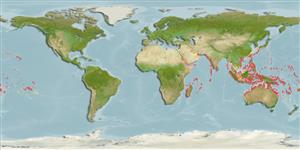Common names from other countries
>
Eupercaria/misc (Various families in series Eupercaria) >
Labridae (Wrasses) > Corinae
Etymology: Hemigymnus: Greek, hemi = half + Greek, gymnos = naked (Ref. 45335).
More on author: Bloch.
Environment: milieu / climate zone / depth range / distribution range
Ecología
marino asociado a arrecife; rango de profundidad 0 - 25 m (Ref. 90102). Tropical; 30°N - 30°S, 33°E - 122°W
Indo-Pacific except the Red Sea.
Tamaño / Peso / Age
Maturity: Lm ? range ? - ? cm
Max length : 30.0 cm TL macho / no sexado; (Ref. 93095)
Short description
Claves de identificación | Morfología | Morfometría
Espinas dorsales (total) : 9; Radios blandos dorsales (total) : 10 - 11; Espinas anales: 3; Radios blandos anales: 11. Lips thick with age (Ref. 1623). Several color phases with age and sex (Ref. 48636). Basic color pattern changes little with growth although the posteriormost white bands disappear on large individuals (Ref. 1602).
Found mostly on coral reefs and reef flats to at least 20 m depth. Juveniles secretive on inshore reefs. Large adults swim openly on reefs, singly or in small loose aggregations (Ref. 48636). Adults feed mainly by taking mouthfuls of sand and gravel, releasing sand from the gill opening after sorting the small animal prey and ejecting the inorganic fragments from the mouth. Gut contents may contain shrimps and 25% the crushed remains of the echinoids Echinometra and Diadema, these were large prey; remaining food material consisted of very small gastopods, bivalves, crabs, ophiuroids, foraminiferans, and unidentified eggs (Ref. 93095). Feed mainly on small crustaceans, mollusks and echinoderms (Ref. 9823). Minimum depth reported taken from Ref. 128797.
Life cycle and mating behavior
Maturities | Reproducción | Spawnings | Egg(s) | Fecundities | Larva
Oviparous, with distinct pairing during breeding (Ref. 205).
Randall, J.E., 2013. Review of the Indo-Pacific labrid fish genus Hemigymnus. J. Ocean Sci. Found. 6:2-18. (Ref. 93095)
IUCN Red List Status (Ref. 130435)
CITES (Ref. 128078)
Not Evaluated
Threat to humans
Harmless
Human uses
Pesquerías: escaso valor comercial; Acuario: Comercial
Herramientas
Special reports
Download XML
Fuentes de Internet
Estimates based on models
Preferred temperature (Ref.
115969): 24.9 - 29.3, mean 28.3 (based on 3355 cells).
Phylogenetic diversity index (Ref.
82804): PD
50 = 0.6250 [Uniqueness, from 0.5 = low to 2.0 = high].
Bayesian length-weight: a=0.00977 (0.00470 - 0.02030), b=3.07 (2.89 - 3.25), in cm Total Length, based on LWR estimates for this (Sub)family-body shape (Ref.
93245).
Nivel trófico (Ref.
69278): 3.5 ±0.37 se; based on food items.
Resiliencia (Ref.
120179): Medio, población duplicada en un tiempo mínimo de 1.4-4.4 años (Preliminary K or Fecundity.).
Fishing Vulnerability (Ref.
59153): Low vulnerability (20 of 100).
